
Erica arborea, the tree heath or tree heather, is a species of flowering plant (angiosperms) in the heather family Ericaceae, native to the Mediterranean Basin and Ethiopia, Kenya and Tanzania in East Africa. It is also cultivated as an ornamental.
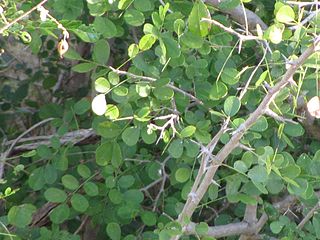
Dalbergia melanoxylon is a flowering plant in the family Fabaceae, native to seasonally dry regions of Africa from Senegal east to Eritrea and south to the north-eastern parts of South Africa. The tree is an important timber species in its native areas; it is used in the manufacture of musical instruments and fine furniture. Populations and genomic resources for genetic biodiversity maintenance in parts of its native range are threatened by overharvesting due to poor or absent conservation planning and by the species' low germination rates.
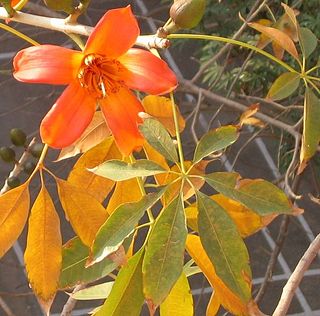
Bombax is a genus of mainly tropical trees in the mallow family. They are native to western Africa, the Indian subcontinent, Southeast Asia, and the subtropical regions of East Asia and northern Australia. It is distinguished from the genus Ceiba, which has whiter flowers.

The conservation status of a group of organisms indicates whether the group still exists and how likely the group is to become extinct in the near future. Many factors are taken into account when assessing conservation status: not simply the number of individuals remaining, but the overall increase or decrease in the population over time, breeding success rates, and known threats. Various systems of conservation status exist and are in use at international, multi-country, national and local levels as well as for consumer use.
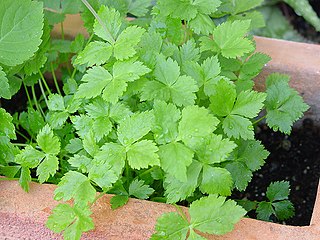
Cryptotaenia, or honewort, is a genus of herbaceous perennial plants, native to North America, Africa, and eastern Asia, growing wild in moist, shady places.

The Kihansi spray toad is a small toad endemic to Tanzania. The species is live-bearing and insectivorous. The Kihansi spray toad is currently categorized as Extinct in the Wild by the International Union for Conservation of Nature (IUCN), though the species persists in ex situ, captive breeding populations.

Juniperus procera is a coniferous tree native to mountainous areas in Africa and the Arabian Peninsula. It is a characteristic tree of the Afromontane flora.
Erythrina schliebenii is a species of legume in the family Fabaceae. It is found only in Tanzania. The species is named for German collector and botanist Hans-Joachim Schlieben.
Rhodognaphalon brevicuspe is a species of flowering plant in the family Malvaceae. It is found in Cameroon, Republic of the Congo, Democratic Republic of the Congo, Ivory Coast, Gabon, Ghana, Nigeria, and Sierra Leone. It is threatened by habitat loss.
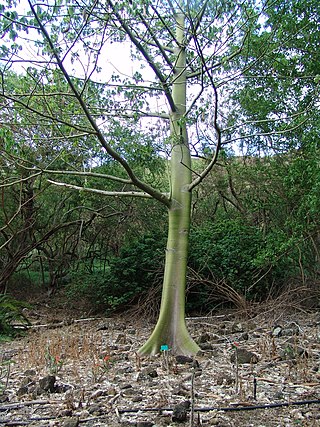
Rhodognaphalon is a genus of flowering plant in the family Malvaceae: found in tropical Africa.

The African green pigeon is a species of bird in the family Columbidae, and one of 5 green pigeon species in the Afrotropics. The species has a wide range in Sub-Saharan Africa with around 17 accepted races.

The white-bellied sunbird, also known as the white-breasted sunbird, is a species of bird in the family Nectariniidae. It is found in Angola, Botswana, Democratic Republic of the Congo, Eswatini, Malawi, Mozambique, Namibia, South Africa, Tanzania, Zambia, and Zimbabwe.
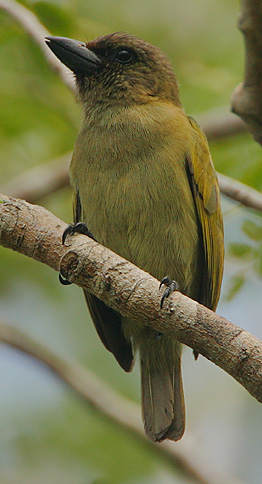
The green barbet is a species of bird in the Lybiidae family. It is found in Kenya, Tanzania, Malawi, Mozambique and South Africa. It occurs in forests from sea level to 1,800 metres (5,900 ft). Its isolated populations are vulnerable to forest clearing.
Alsodeiopsis schumannii is a species of plant in the Icacinaceae family. It is endemic to Tanzania, specifically the East Usambara, the Uluguru Mountains, and the Southern Highlands.
Ficus faulkneriana is a species of strangler fig in the family Moraceae native to Africa.

Lygodactylus williamsi is a critically endangered species of lizard in the family Gekkonidae. The species is endemic to a small area of Tanzania. Common names include turquoise dwarf gecko, William's dwarf gecko, and, in the pet trade, electric blue gecko.

Nuxia floribunda, the forest elder, forest nuxia or wild elder, is a species of tree in the Stilbaceae family, that is native to moist regions of southern Africa, East Africa and central tropical Africa.

Ilex mitis is a tall, dense, evergreen tree that is indigenous to Sub-Saharan Africa and Madagascar. It makes an excellent fast-growing hedge for gardens - growing tall, straight and dense.
The Flora of Tropical East Africa (FTEA) is a catalogue of all 12,104 known wild plant species in Uganda, Kenya, and Tanzania. The project began in 1948 and was finally completed in September 2012. Approximately 1,500 new plant species were described, by 135 botanists from 21 countries.

Streptocarpus ionanthus is a species of Streptocarpus in the section Saintpaulia, commonly known as an African violet. It is native to eastern and southwestern Tanzania.
















